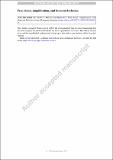| dc.contributor.author | Bar-Lev, Moshe E. | |
| dc.contributor.author | Fox, Daniel | |
| dc.date.accessioned | 2020-12-17T22:54:44Z | |
| dc.date.available | 2020-12-17T22:54:44Z | |
| dc.date.issued | 2020-03 | |
| dc.identifier.issn | 0925-854X | |
| dc.identifier.issn | 1572-865X | |
| dc.identifier.uri | https://hdl.handle.net/1721.1/128853 | |
| dc.description.abstract | We propose a modification of the exhaustivity operator from Fox (in: Sauerland and Stateva (eds) Presupposition and implicature in compositional semantics, Palgrave Macmillan, London, pp 71–120, 2007. https://doi.org/10.1057/9780230210752_4) that on top of negating all the Innocently Excludable alternatives affirms all the ‘Innocently Includable’ ones. The main result of supplementing the notion of Innocent Exclusion with that of Innocent Inclusion is that it allows the exhaustivity operator to identify cells in the partition induced by the set of alternatives (assign a truth value to every alternative) whenever possible. We argue for this property of ‘cell identification’ based on the simplification of disjunctive antecedents and the effects on free choice that arise as the result of the introduction of universal quantifiers. We further argue for our proposal based on the interaction of only with free choice disjunction. | en_US |
| dc.publisher | Springer Science and Business Media LLC | en_US |
| dc.relation.isversionof | https://doi.org/10.1007/s11050-020-09162-y | en_US |
| dc.rights | Creative Commons Attribution-Noncommercial-Share Alike | en_US |
| dc.rights.uri | http://creativecommons.org/licenses/by-nc-sa/4.0/ | en_US |
| dc.source | Springer Netherlands | en_US |
| dc.title | Free choice, simplification, and Innocent Inclusion | en_US |
| dc.type | Article | en_US |
| dc.identifier.citation | Bar-Lev, Moshe E. and Danny Fox. "Free choice, simplification, and Innocent Inclusion." Natural Language Semantics 28, 3 (September 2020): 175–223 © 2020 Springer Nature B.V. | en_US |
| dc.contributor.department | Massachusetts Institute of Technology. Department of Linguistics and Philosophy | en_US |
| dc.relation.journal | Natural Language Semantics | en_US |
| dc.eprint.version | Author's final manuscript | en_US |
| dc.type.uri | http://purl.org/eprint/type/JournalArticle | en_US |
| eprint.status | http://purl.org/eprint/status/PeerReviewed | en_US |
| dc.date.updated | 2020-09-24T20:37:14Z | |
| dc.language.rfc3066 | en | |
| dc.rights.holder | Springer Nature B.V. | |
| dspace.embargo.terms | Y | |
| dspace.date.submission | 2020-09-24T20:37:14Z | |
| mit.journal.volume | 28 | en_US |
| mit.journal.issue | 3 | en_US |
| mit.license | OPEN_ACCESS_POLICY | |
| mit.metadata.status | Complete | |
